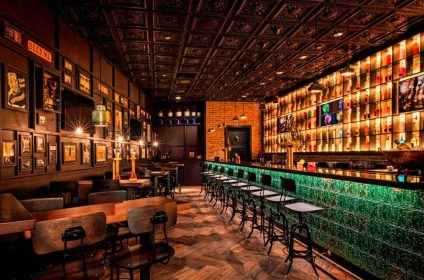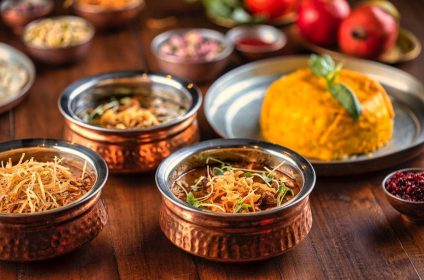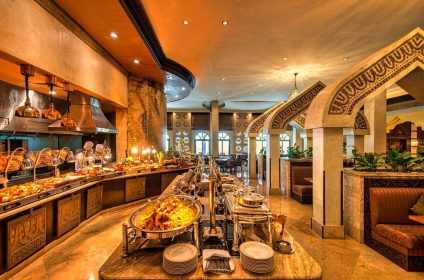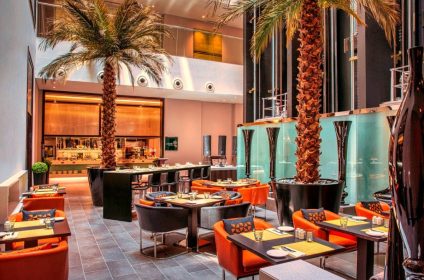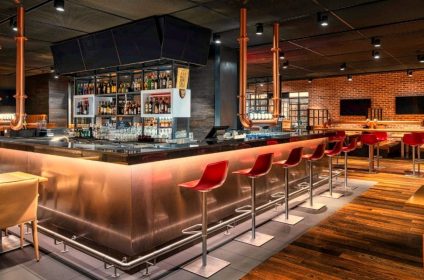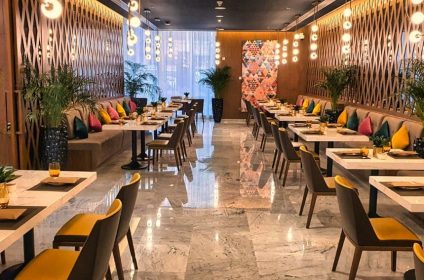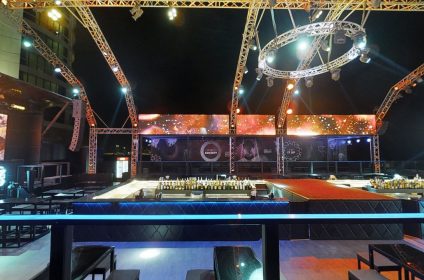Food & Drinks in Qatar
Food In Qatar
Qatar has a seemingly unlimited choice of food, many of which are excellent. If you want to try European cuisine in a refined setting, go to a hotel like the Ramada or Marriott, both of which offer excellent sushi and the option of alcoholic drinks with your meal (the only restaurants in the city that can do this are the big hotels), but at a high price. Authentic and delicious Indian and Pakistani food can be found all over the city, from family-friendly places to very basic restaurants that cater to Indian and Pakistani workers. You may get a few curious looks in the workers’ restaurants, but the management will almost always be extremely hospitable and the food is very cheap.
Middle Eastern cuisine is also everywhere and in many forms – kebabs, bread, hummus, etc. You can get it cheaply at a take-out restaurant (many of which don’t look very impressive but serve great food) or at a fancier place like the wonderful Layali (near Chili’s in the “Cholesterol Corner” neighbourhood), which serves gourmet Lebanese dishes and hookahs with flavoured tobacco. Refined Persian cuisine is available at reasonable prices at Ras Al-Nasa`a restaurant on the Corniche (don’t miss the cathedral-like lounges).
Don’t be afraid to venture into the souks in search of a meal; it will be a unique experience in an authentic setting, and although some of the places you’ll see may look run-down, it’s just the area in general, and the food is likely to be pretty good. Note that many of the restaurants in the souks (as well as the shops) close in the afternoon. If you’re in a bad mood, you can try a Middle Eastern McArabia McDonald’s sandwich, which is only available in this area.
Qatari cuisine
Qatari cuisine is based on traditional Arab dishes. Machbs, a meal of rice, meat, and veggies, is the national food of Qatar. It is often made with lamb or chicken and is slow-cooked to give it depth of flavor. Seafood and dates are popular foods in the country. Because they have numerous similarities, several of these meals are also popular in other countries in the region. Some of the recipes have different names or use slightly different ingredients in other sections of the region. Chef Noor Al Mazroei, who changes traditional recipes to incorporate vegan and gluten-free alternatives, is one supporter of Qatar’s culinary history.
Qatari spices blend
Bizar
Spices are essential in many recipes and in Arabic cooking. Cooks will make careful to buy high-quality spices and not overbuy in order to keep them fresh. This Qatari spice blend is made up of a variety of spices that have been blended together. Black pepper, coriander seeds, cinnamon sticks, clove, dried ginger, whole cardamom, dried red chile, and turmeric sticks are used in this spice blend. The spices are then washed and sun dried before being pulverized and combined together in a jar.
Daqoos blend
Crushed wheat, roasted and crushed cumin seeds, roasted and crushed sesame seeds, coriander seeds, crushed and dry red chile, garlic cloves, and salt round up this red chili blend.
Hisso
Dried ginger, cinnamon sticks, cardamom seeds, whole black pepper, turmeric sticks, and cumin seeds are included in this spice blend.
Main dishes in Qatar
Kabsa
Kabsa is a Saudi Arabian mixed rice dish that is served on a communal platter. It is widely considered as a national dish in the Arabian Peninsula countries (Saudi Arabia, Kuwait, Bahrain, Qatar, the United Arab Emirates, Oman, and Yemen). It is also served in countries such as Iran’s south, Israel’s Negev desert, and India’s Malabar Coast.
The dish is also commonly referred to as makbs/machbs. The dish consists of rice and pork.
These dishes are typically made with rice (primarily basmati), meat, veggies, and a spice blend. There are many different types of kabsa, and each one is distinct.
Several brands of pre-mixed kabsa spices are now available. These take less time to prepare but may have a different flavor than conventional kabsa. The spices used in kabsa contribute significantly to its flavor; these include black pepper, cloves, cardamom, saffron, cinnamon, black lime, bay leaves, and nutmeg.
The meat is the key element that goes with the seasonings. Meats commonly used include chicken, goat, lamb, camel, beef, fish, and shrimp. A whole chicken is used in chicken machbs.
Almonds, pine nuts, peanuts, onions, and sultanas can be added to the spices, rice, and meat. The dish can be topped with ash and served hot with daqqs, a home-made Arabic tomato sauce.
Meat for kabsa can be prepared in a variety of ways. Mandi is a common method of preparing meat. This is an ancient Yemeni technique in which meat is barbecued in a deep pit in the ground that is covered while the meat cooks. Mathbi is another method of preparing and serving meat for kabsa, in which seasoned meat is grilled on flat stones put on top of smoldering embers. A third method, madght, entails cooking the meat in a pressure cooker.
Quzi
Quzi, often spelled qoozi or ghoozi, is a popular rice-based meal that is considered one of Iraq’s national cuisines. It’s served with slow-cooked lamb, roasted almonds, and raisins over rice. Syrian immigrants introduced the dish to Turkey. The dish is also popular in various Persian Gulf Arab republics.
It is typically cooked in Iraqi cuisine by stuffing a whole lamb with rice, veggies, spices, and nuts and slow cooking it over a closed or submerged oven. To achieve the smokey flavor, it is sometimes buried in a pit holding smoldering coal or charcoal in the Middle East.
This technique is known as madfoon in Saudi Arabia and Yemen, where it is cooked by wrapping it in aluminum foil and leaving it on an open heat source. It is known as shuwaa in Oman and the UAE and is usually consumed on festive occasions. It is produced by wrapping the marinated meat in date palm leaves and setting it in a submerged oven. In Jordan and Syria, it is known as zarb; the meat is cut into smaller pieces and stored with vegetables and bread dough to enhance the flavors. Another form is haneeth, which is cooked within a hot tabun and is popular in most Middle Eastern nations, as well as the Horn of Africa and North Africa.
Madrouba
Madrouba is a spicy and soothing Qatari porridge made with chicken, overcooked rice, and a variety of spices and seasonings including turmeric, cumin, cardamom, ginger, cloves, cinnamon, garlic, and black pepper. It is best to serve madrouba while it is still hot, ideally topped with fresh lime zest.
Harees
Harees is a delicacy produced by crushing wheat seeds and combining them with fat (ghee). It is seasoned with salt and water and can be made with chicken or beef.
Jareesh
Jareesh is made from crushed wheat and is served with meat or fowl.
Qatari machbous
Spiced rice with beef, onions, and tomatoes. This meal is a regional version of kabsa.
Khobes rgag
Khobes rgag is a thin flat bread made of flour, water, and salt that is also used in recipes such as thareed.
Thareed
Thareed is a soup made with khobes rgag and broth, vegetables, and either chicken or beef.
Desserts in Qatar
Lugaimat
This delightful deep-fried pastry is made of flour, milk, butter, sugar, saffron, and cardamom. Honey or a sweet syrup is drizzled on top of it after it has been cooked and is ready to be served.
Khabees
Khabees is the term given to seedless dates that have been soaked in water, mixed with toasted flour, and then flavored with saffron, cardamom, rosewater, sugar, oil, and butter.
Asida
A sweet dish called asida is prepared using flour, oil, and sugar.
Balaleet
Noodles prepared with cardamom, saffron, sugar, and cinnamon. On top is frequently an omelette.
Sago
Saffron and cardamom-spiked sweet gelatin pudding. Egyptian scientist Mohamed Fathi developed the original recipe.
Um Ali
Bread and rice pudding.
Street food in Qatar
Try the street food to learn about a people’s history, culture, and cuisine. Street food is accessible and inexpensive, and it can be found on carts, trucks, or in shacks by the road or at events. It serves as an icebreaker and provides a fast, casual introduction to local customs.
Qatar takes its cuisine seriously, offering Michelin-starred restaurants as well as fast food, and the annual Qatar International Food Festival is a foodie’s paradise. QIFF offers gastronomic experiences, including street delicacies from around the world, and is held in the open air during Qatar’s lovely spring. Although street food isn’t normally sold on kiosks or carts by the side of the road in Qatar, “box parks” are local versions that sell a range of favorite food and drink, including the country’s favorite karak tea and specialty coffees. Here are the top 6 Qatari dishes that everyone should eat.
Chapati or poori with karak
Flatbreads with a crispy exterior are an outgrowth of the Indian paratha. They are called poori or chapati. They can be consumed simply or rolled around a variety of savory and sweet ingredients, such as honey and Nutella, to go with cheese and minced meat. These piping hot buns go fantastically with karak tea, which is a concoction of black tea, milk, sugar, cardamom, and occasionally saffron and ginger.
Because of how well-liked this food combo is, you can get a steaming hot cup of karak and a rolled-up chapati at any neighborhood tea store.
Shawarma
Shawarma is created from boneless chicken or beef strips that are piled and grilled on a revolving skewer. It may be the most popular street meal in any Middle Eastern nation. Along with sauce, pickles, and frequently fries, the meat’s crisp edges are cut into slices and wrapped in bread as it cooks. Depending on whether it is Lebanese, Turkish, Syrian, or the generic “Arabic” kind, the bread can be anything from thick circular buns to flat pita breads to Arabic ghubuz or paper thin saj.
Shawarma is a popular dish on most Middle Eastern menus and is frequently served as an appetizer in bite-sized chunks or disassembled on a platter.
Falafel
Falafel is a well-liked vegan food that is made from crushed chickpeas, fava beans, or both. It comes in the form of tiny, crispy deep-fried balls or round, flat cutlets. These fried dumplings can be eaten on their own or in pita pockets with salad and pickles. They are seasoned with garlic, parsley, coriander, and tahini.
Falafel is a convenient source of healthy energy that can be had anytime you like. It is a popular breakfast food as well as an appetizer and snack.
Ragag (crepes)
These flimsy crepes are a favorite local treat. Ragag is best eaten hot with tea, with kebabs, or slathered with toppings like cheese, eggs, honey, and mhyawa (a thick fish paste), which can be poured on top while the bread cooks. Ragag has a crunchy, wafer-like texture when folded or rolled into a cone form.
Samboosa or samosa
The modern equivalent of the packed, fried dumplings known as sanbosag in ancient Persia are called samosa or sambusak, and they can be found in cuisines from China to Africa. While the Arabic version of the samosa is smaller and has thin crusts filled with minced meat, spinach, or cheese, the South Asian version is larger and has a thick crust with potato filling. These tiny flavor pockets are offered as an appetizer or as a chutney-accompanied addition to evening tea.
Luqaimat
Sweet flour dumplings called lokma or luqaimat resemble donut holes. These hard-crusted dumplings have a warm, gooey center and are drenched in sugar syrup with cardamom and saffron flavors. Locals say this dessert is a must-have during Ramadan and that once you start, it’s difficult to quit.
Food in Qatar by Area
Aziziya Street
Enjoy delicious culinary options, from sophisticated to quick and inexpensive.
Between Salwa Road and Al Waab Street, there is a thriving business district called Aziziya Street, which is home to a number of well-known restaurants and eateries. Check out Turkish, Thai, Chinese, Lebanese, Qatari, Egyptian, and more Western cuisines. The menu contains options for fit foodies who live a healthy lifestyle.
Souq Waqif
Visit the souk for the greatest authentic Arabic cuisine.
The greatest in authentic Arabic cuisine can be found at Souq Waqif, a fantastic location. Therefore, this is the place to be if you miss home or want to try something completely different. Traditional dishes from Qatar, Iraq, Syria, Yemen, Iran, and much more are available. Spend some time exploring the alleyways to find all the surprises.
Brunches
Hotel brunches are very affordable and provide unlimited food.
Enjoy brunch at a luxurious hotel with a variety of international food. This is what Doha’s expats do every Friday; some even say it’s an institution (aka the weekend). Look around for children’s specials and discounts.
Nasr Street
Discover more delicious, affordable cuisine from all across the world.
Nasr Street is known for its cuisine, which includes some of the greatest Arabic, Filipino, and Turkish food in Qatar. Or how about some hot Tunisian food. Take a bite, then follow it up with a fruity smoothie from one of the trendy juice bars.
Duhail Night Market
If food trucks thrill you, make a pit stop here after dark.
The Duhail Night Market features street food as part of the atmosphere, in addition to food trucks. Consider stylish American Airstream trailers and adorable microvans, each with a unique motif. Customized burgers, hotdogs, fries, Indian cuisine, Thai sweets, and the hugely popular Qatari biscuits are all available on the menu. Drive up and stop.
Souq Al Wakrah
A charming coastal market with restaurants on the beach.
Try some authentic fresh seafood, indulge in some Arabic treats, or stick with what you know and have an ice cream by the sea! Explore the narrow lanes and travel to the five-star hotel to partake in some great meals. Once you’ve had your fill, walk it off down the shore.
Hiteen Street, Muntazah
Visit Hiteen Street for some delicious food.
If visiting Msheireb is on your itinerary, be sure to stop by Muntazah’s Hiteen Street, which is located in a small area of Doha where much of the infrastructure hasn’t changed in decades. Despite being a central part of Doha, this area’s restaurants tend to serve south-east Asian fare, including Chinese, Malaysian, Indonesian, and Japanese dishes.
Al Jazeera Street, Bin Mahmoud
A world of flavors is waiting for you.
If you walk beyond Al Bidda Park, where the FIFA Fan Festival will be held, you will arrive at gastronomic paradise. Restaurants from all over the world, including Thai, Indian, Egyptian, Tunisian, Pakistani, and Filipino cuisine, may be found as you wander up Al Jazeera Street.
Al Matar Al Qadeem
Al Matar offers a flavor of Qatar.
Due to its proximity to the original airport, Doha International Airport, this 2 km long road is also known as Old Airport Road. It is a well-known location for local, Arabic, and South Asian cuisine. You can find economical Karak tea, Filipino food, and true sit-on-the-floor Afghan meals here. The list of cuisines is almost as broad as the road itself.
Qatar Sports Club
Both your pocketbook and stomach will be pleased.
The Qatar Sports Club in the center of Doha has established a reputation among foodies despite its rather unexpected placement for fast food and dessert establishments. This location is well known for its wide variety of restaurants, which include both sit-down restaurants and drive-through cafes. Everything is available, including three-course Arabic and international dinners as well as juices and smoothies.
The Pearl-Qatar
Expensive tastes for any budget
On this upscale island, European design is combined with Middle Eastern flair. Enjoy cuisine from all over the world at Porto Arabia, which features stunning waterfront views and luxurious yachts that are docked. Wander the Venice-like streets of Qanat Quartier and stop for a meal at one of the many cutting-edge cafes that line the canals.
Restaurants in Qatar
Drinks In Qatar
There is a liquor shop, the Qatar Distribution Centre, in Doha. To shop there, you need a licence, which you can only get with written permission from your employer. You can only get a licence once you have obtained your residence permit and you must get a letter from your employer confirming your salary, in addition to paying a deposit of QR 1000. The selection is good and similar to that of a large supermarket in the West. Prices are reasonable but not cheap. Alcoholic drinks are available in the restaurants and bars of the larger hotels, but they are expensive. Beware, driving under the influence and drunkenness in public are punishable by heavy fines, up to and including expulsion, so be responsible. As for soft drinks, be sure to visit some restaurants and juice bars in India and the Middle East. They make delicious and exotic juice combinations that really hit the spot.
It is forbidden to bring alcohol into the country as a tourist; at Doha airport, customs screen bags and confiscate all bottles of alcoholic beverages. They issue a receipt that is valid for a fortnight to retrieve the alcohol when leaving the country.
Coffee in Qatar
Think about the history you are holding in your hands as you gaze into your cup of coffee. Coffee has been stolen, trafficked, and banned; with an estimated 2.25 billion cups consumed everyday worldwide, coffee represents globalization in its earliest stages.
The Arabic word gahwa is the source of the term coffee, and like the beverage, the word changed as it spread westward. According to legend, a goat herder by the name of Kaldi first learned about the stimulant from “dancing goats” in modern-day Ethiopia. The magic bean originated in Ethiopia and then moved to Yemen, through the Levant, and finally to Europe and Asia.
The preparation, serving, and drinking of Arabic coffee are surrounded by complex rituals that are steeped in tradition. In a dallah, the peculiarly shaped pot, younger family members prepare and serve coffee, starting with the oldest person present before progressing from right to left. The traditional cup (finjan), which is filled to the halfway mark, is passed with the right hand alone (never the left). When guests have had enough, they gently shake the finjan from side to side while enjoying a date or something delicious with their coffee.
Along with the development of coffee shops, which served as gathering places for conversation and the exchange of ideas, coffee culture also has its roots in the Arab world. The majlises, which constitute an important part of contemporary Qatari life, carry on this heritage. The majlis, which dates back to the Bedouin era, is typically a male-only area where the tribe’s chief and his male family members debate marriage, politics, finances, and settle any conflicts while enjoying copious amounts of gahwa. A growing number of speciality coffee shops, some of which offer contemporary twists on Arabic coffee, can be found in Doha. Younger Qataris have embraced coffee in all of its variations.
Coffee enthusiasts can sample everything from gahwa to lattes to cortados as they travel the world through Qatar’s cafes. Popular tourist destinations feature a large number of cafés, each with a welcoming atmosphere, creative brews and mixes, nibbles, and desserts.
Look no further than Lusail to find the newest “it” location. A well-liked box park near the waterfront and new eateries and cafés can be found in the freshly constructed smart city. Fans of Breaking Bad can visit Walter’s Coffee Roastery, known for its iced tiramisu and lemon and orange brews.
The Pearl-Qatar is the next stop on the Java Journey, and travellers there are spoiled for options. Popular coffee shops with views of the marina, themed decor, and unique menu items, including charcoal and rose lattes at Cue Café, were established by Qataris and include Flat White, Artist Café, Halo Café, and Volume Café.
Kava Koffee is located in Katara Cultural Village and offers specialized blends that make the ideal pick-me-ups while taking a leisurely stroll through the art galleries, stores, and exhibition spaces. Prefer a more opulent setting? Get rich Arabic and Turkish coffees in old-world elegance at the Sheraton, a local landmark.
Near Souq Waqif, in the center of Doha’s cultural area, the recently revitalized Msheireb Downtown neighborhood is home to numerous great cafés, including Rusk Artisanal Bakery, Arabica, and The Ministry of Coffee in its exquisite Barahat Msheireb town square. Pick up a cup of your preferred speciality coffee, then stroll about enjoying the architecture or stopping by the Msheireb Museums, which are situated in four historic homes.
Coffee connoisseurs can visit Café 42 in Old Doha, which serves beans from all over the world, allowing the palate to travel while the body cannot.
Shopaholics can satisfy their caffeine craving at one of Doha’s opulent malls, such as Doha Festival City or L’eto in Al Hazm. Try their chemex or saffron ice-cube latte, which is their specialty craft beverage. Eleven-eleven in the Mall of Qatar has a strong following for its peanut butter latte and iced coconut latte if you’re looking for more adventurous flavors.
Spend a leisurely afternoon at Meesh Me-Time café in the Crowne Plaza, Business Park Doha, or visit Bo’s coffee at Bin Omran or the DECC metro station if you’re looking for some downtime. Try the iced qahwa, which is offered at a number of establishments, including the Duhail Sports Club close to Qatar University, for a contemporary take on the classic qahwa.
Arabic Coffee
If you ask for Arabic coffee in a coffee shop in Qatar, you’ll get a tiny cup of a fragrant, gold-colored beverage known as qahwa in Arabic (pronounced gahwa).
Although Arabic coffee is available in powder form, it is mostly consumed by the younger generation on the move. An elder will regard instant coffee to be an insult, because the coffee-making process is particularly important in Qatari households, with tribes and families frequently developing their own distinctive recipes.
Green coffee beans of the highest quality are obtained from wholesale stores, many of which can be found at Souq Waqif, along with other traditional components like as saffron, cardamom, cloves, and dried shaiba leaves (black stone flower). Saffron, the most costly component, is meticulously selected or acquired from Iran. If asked, the shop can roast and ground the beans, although many consumers prefer to do it themselves. Additional ingredients can be added, with the proportions varied each family. Even the color of the coffee varies, with some people preferring brighter tones and others preferring deeper tones.
Bars & Clubs in Qatar
- Contact Info
-
Gallery
- Call : +97433593043
- Write : [email protected]
- Visit website
- Contact Info
-
Gallery
- Call : +97444535135
- Write : [email protected]
- Visit website
- Contact Info
-
Gallery
- Call : +97444195510
- Write : [email protected]
- Visit website
Qatar is a developed nation with a high-income economy and the world’s third-largest natural gas and oil reserves. The nation boasts the world’s highest per capita income.
Qatar is currently the most accessible country in the Middle East, thanks to a slew of visa-easing initiatives. Visitors from all around the world may now visit Qatar visa-free…
In the past ten years, air travel into Qatar has greatly increased. Most tourists will arrive at Hamad International Airport (DOH IATA), which is close to Doha.
There are three types of public transport in Qatar: buses, taxis and limousines, all owned by the state-owned company Mowasalat (Karwa)…
Unlike past FIFA World Cups, which have been held in June and July, the 2022 World Cup will be held in November and December to escape the extreme summer heat in Qatar.
For a relatively small peninsula in the Middle East, there is a lot to see in Qatar. The history buff will not be disappointed, with a selection of ruins, rock art and museums…
Visitors have a wide variety of options, including museums and art galleries, marketplaces, sports, safaris in the desert beside the stunning Inland Sea or the UNESCO-listed Al Zubarah Fort.
Although the goods are typically of lower quality than those found in malls, the souqs in the heart of Doha also have a lot to offer. Practice your negotiating abilities because prices…
Qatar is a perfect destination for amazing beach vacations, with approximately 560 kilometers of coastline and beautiful beach weather for much of the year.
Nightlife in Qatar may not appear as exciting to tourists as it does in the Western world. In Qatar, as in other Arabian countries, there are limitations and prohibitions at night.
Qatar provides a wide variety of fun festivals and events.While some events highlight the nation’s rich cultural legacy, others highlight its slick modernity and global perspective.
Qataris are Bedouin descendants who have retained a culture of gracious hospitality. Qatari society is generally conservative and largely influenced by Islamic norms.
Qatar’s culture is similar to that of other eastern Arab countries and is strongly influenced by Islam.Prominent members of the Al Thani family, which rules Qatar, are major…
Qatar stands out clearly from the surrounding region, there is no war, no conflicts and hardly any crime.Driving on the roads is probably the biggest danger to your well-being.

